Thursday, April 30th 2020

Intel 10th Generation Comet Lake Desktop Processors and 400-Series Chipsets Announced, Here's what's New
Intel today launched its 10th generation Core desktop processor family and its companion Intel 400-series chipsets. Based on the 14 nm++ silicon fabrication process and built in the new LGA1200 package, the processors are based on the "Comet Lake" microarchitecture. The core design of "Comet Lake" and its IPC are identical to those of "Skylake," however Intel brought significant enhancements to the processor's clock-speed boosting algorithm, increased core- or thread counts across the board, and introduced new features that could interest enthusiasts and overclockers. The uncore component remains largely unchanged from the previous-generation, with support for DDR4 memory and PCI-Express gen 3.0. Use of these processors requires a new socket LGA1200 motherboard, they won't work on older LGA1151 motherboards. You can install any LGA115x-compatible cooler on LGA1200, provided it meets the thermal requirements of the processor you're using.
At the heart of the 10th generation Core processor family is a new 10-core monolithic processor die, which retains the same basic structure as the previous-generation 8-core "Coffee Lake Refresh" die, and 4-core "Skylake." The cores are arranged in two rows, sandwiched by the processor's uncore and iGPU blocks. A ring-bus interconnect binds the various components. The cache hierarchy is unchanged from previous generations as well, with 32 KB each of L1I and L1D caches; 256 KB of dedicated L2 cache per core, and 20 MB of shared L3 cache. The iGPU is the same Gen 9.5 based UHD 630 graphics. As we mentioned earlier, much of Intel's innovation for the 10th generation is with the processor's microcode (boosting algorithms).The 10-core die with all its cores enabled is the backbone of the new 10th generation Core i9 series, including the flagship part, the Core i9-10900K, a 10-core/20-thread processor with maximum clock speeds running as high as 5.30 GHz, which Intel claims is the "fastest processor for gaming." All Core i9 SKUs in the series are 10-core/20-thread. The Core i9-10900K is unlocked and features an iGPU. The i9-10900KF is unlocked, but lacks an integrated graphics (it is physically present in the silicon, but disabled). The i9-10900 has an iGPU, but isn't unlocked. The i9-10900F both lacks an iGPU and is multiplier-locked. These chips are priced between $422 and $488 (1,000-unit tray quantities).The 10th generation Core i7 series, sold at price points under $400, consists of 8-core/16-thread parts with 16 MB of shared L3 cache - the same amount of muscle as the 9th generation Core i9 series. Leading this line is the Core i7-10700K, clocked up to 5.10 GHz. Among the SKUs are the i7-10700K, the i7-10700KF, i7-10700, and i7-10700F.
The 10th generation Core i5 series sees the most bolstering, in our opinion. The popular middle-of-the-market chips are now 6-core/12-thread, with 12 MB of shared L3 cache, across the board (same amount as the 8th generation Core i7 series). Leading the pack is the Core i5-10600K, followed by the i5-10600KF, and i5-10600, i5-10500, i5-10400, and the i5-10400F. These SKUs cover the broadest range of price-points starting at just $157 for the i5-10400F, going up to $262 for the unlocked i5-10600K.
The 10th generation Core i3 series also sees a hefty bit of hardware enhancement. These are 4-core/8-thread parts, with up to 8 MB of shared L3 cache (same as the 7th generation Core i7 series). The i3-10300 and i3-10320 feature 8 MB of L3 cache, while the entry-level i3-10100 features 6 MB of it. The i3-10100 is priced at $122, the i3-10300 at $143, and the i3-10320 at $154. There is no unlocked part in the Core i3 series.
At the bottom of the pile are Pentium Gold socket LGA1200 G6000-series 2-core/4-thread processors with 4 MB of L3 cache, and Celeron G5900 series 2-core/2-thread parts with 3 MB L3 cache.
Intel sticking with 14 nm comes with heavy costs on the energy-efficiency front. All unlocked K-SKUs in the series come with an unprecedented 125 W TDP rating (older generations of Intel LGA115x processors almost never had a TDP rating higher than 95 W). Almost all socket LGA1200 motherboards we've seen so far, barring the Mini-ITX designs, feature at least an 8+4 pin EPS (CPU power) input configuration. The higher-end boards even have dual 8-pin EPS setups akin to HEDT motherboards.
We asked Intel and they confirmed that Z490 is built on a 14 nm production process. It connects to the LGA1200 processor over a conventional DMI 3.0 chipset bus (32 Gbps per direction). Connectivity is an impressive 24 PCI-Express 3.0 downstream lanes, which combined with the 16 PEG lanes from the processor add up to 40 lanes on this platform. Motherboard designers utilize this PCIe lane budget to deploy up to three M.2 NVMe slots, and several high-bandwidth devices such as additional USB 3.2 host controllers, Thunderbolt 3 controllers, 10 GbE networking, etc.
The Z490 integrates a 6-port SATA 6 Gbps AHCI/RAID controller, a 4-port USB 3.2 gen 2 controller with Gen 2 x2 (20 Gbps) capability, up to 12 USB 3.2 gen 1 (5 Gbps) ports, a HD Audio bus with Intel Smart Sound (low-power audio encoding/decoding) capability, which lets you issue voice commands to your PC even in standby mode; and one integrated MAC for either an i225-V "Foxville" 2.5 GbE or cheaper i219-V "Jacksonville" 1 GbE controller. The chipset also comes with preparation for Intel AX201 WLAN card over CNVi interface (802.11ax Wi-Fi + Bluetooth 5).
At the heart of the 10th generation Core processor family is a new 10-core monolithic processor die, which retains the same basic structure as the previous-generation 8-core "Coffee Lake Refresh" die, and 4-core "Skylake." The cores are arranged in two rows, sandwiched by the processor's uncore and iGPU blocks. A ring-bus interconnect binds the various components. The cache hierarchy is unchanged from previous generations as well, with 32 KB each of L1I and L1D caches; 256 KB of dedicated L2 cache per core, and 20 MB of shared L3 cache. The iGPU is the same Gen 9.5 based UHD 630 graphics. As we mentioned earlier, much of Intel's innovation for the 10th generation is with the processor's microcode (boosting algorithms).The 10-core die with all its cores enabled is the backbone of the new 10th generation Core i9 series, including the flagship part, the Core i9-10900K, a 10-core/20-thread processor with maximum clock speeds running as high as 5.30 GHz, which Intel claims is the "fastest processor for gaming." All Core i9 SKUs in the series are 10-core/20-thread. The Core i9-10900K is unlocked and features an iGPU. The i9-10900KF is unlocked, but lacks an integrated graphics (it is physically present in the silicon, but disabled). The i9-10900 has an iGPU, but isn't unlocked. The i9-10900F both lacks an iGPU and is multiplier-locked. These chips are priced between $422 and $488 (1,000-unit tray quantities).The 10th generation Core i7 series, sold at price points under $400, consists of 8-core/16-thread parts with 16 MB of shared L3 cache - the same amount of muscle as the 9th generation Core i9 series. Leading this line is the Core i7-10700K, clocked up to 5.10 GHz. Among the SKUs are the i7-10700K, the i7-10700KF, i7-10700, and i7-10700F.
The 10th generation Core i5 series sees the most bolstering, in our opinion. The popular middle-of-the-market chips are now 6-core/12-thread, with 12 MB of shared L3 cache, across the board (same amount as the 8th generation Core i7 series). Leading the pack is the Core i5-10600K, followed by the i5-10600KF, and i5-10600, i5-10500, i5-10400, and the i5-10400F. These SKUs cover the broadest range of price-points starting at just $157 for the i5-10400F, going up to $262 for the unlocked i5-10600K.
The 10th generation Core i3 series also sees a hefty bit of hardware enhancement. These are 4-core/8-thread parts, with up to 8 MB of shared L3 cache (same as the 7th generation Core i7 series). The i3-10300 and i3-10320 feature 8 MB of L3 cache, while the entry-level i3-10100 features 6 MB of it. The i3-10100 is priced at $122, the i3-10300 at $143, and the i3-10320 at $154. There is no unlocked part in the Core i3 series.
At the bottom of the pile are Pentium Gold socket LGA1200 G6000-series 2-core/4-thread processors with 4 MB of L3 cache, and Celeron G5900 series 2-core/2-thread parts with 3 MB L3 cache.
Intel sticking with 14 nm comes with heavy costs on the energy-efficiency front. All unlocked K-SKUs in the series come with an unprecedented 125 W TDP rating (older generations of Intel LGA115x processors almost never had a TDP rating higher than 95 W). Almost all socket LGA1200 motherboards we've seen so far, barring the Mini-ITX designs, feature at least an 8+4 pin EPS (CPU power) input configuration. The higher-end boards even have dual 8-pin EPS setups akin to HEDT motherboards.
What's Really New
As we explained earlier, the core IPC of the 10th generation "Comet Lake" microarchitecture is unchanged from the previous generation, much of Intel's innovation is focused on getting the most out of their existing core design. The following is a list of what's really new:- HyperThreading across the board: Intel extended HyperThreading to be available across most of their product line. HT was originally reserved for only top-tier parts, but can now be found on the Core i9, Core i7, Core i5, Core i3, and Pentium Gold parts. SMT is a proven way to dial up multi-threaded application performance by leveraging idle hardware resources in a CPU core, and brings about tangible multi-threaded performance uplifts.
- Up to Three Different Boosting Algorithms: Intel has up to three different clock speed boosting algorithms deployed on various SKUs in the series:
- Turbo Boost 2.0: This is the most basic boosting technology, available across all 10th gen Core i9, Core i7, Core i5, and Core i3 SKUs
- Turbo Boost MAX 3.0: Carried over from the Core X HEDT processor family, Turbo Boost Max 3.0 is now available on 10th Gen Core i9 and Core i7 SKUs, enabling higher notches of clock speed than Turbo Boost 2.0, and it also adds "Favored Cores". This makes the operating system aware the two physically-best cores, which can sustain higher boost frequencies better than the rest of the CPU. The goal is to have the OS scheduler prioritize running workloads on these cores, so they can run faster. Windows 10 has had Favored Core awareness since 1609, and Linux x64 kernels since January 2018 have supported it.
- Thermal Velocity Boost: Carried over from its 9th and 10th generation Core mobile processors, Thermal Velocity Boost is available to 10th generation Core i9 SKUs. The feature enables clock boost speeds even higher than Turbo Boost MAX 3.0, in short bursts, provided your processor's cooling solution is able to consistently keep temperatures below a threshold, and provided a few power targets are met. We confirmed with Intel that for the 10th gen desktop chips, this threshold is set at 70 °C (for the mobile parts it is 65 °C).
- New Core and Memory overclocking features, including:
- The ability to enable or disable HyperThreading for individual cores. Until now, you could disable or enable HTT only globally. This comes as a boon for gamers who want to set a few of their cores without HTT, and a few with HTT for streaming applications
- Enhanced, finer grained voltage/frequency curve controls. Intel is launching a major update to XTU alongside these processors, which lets you set the voltage at individual frequencies, for much finer control of overclocking parameters. This technique was pioneered by GPU vendors and helps reduce power in situations when the CPU is not running at highest frequency. Traditionally you could either program a voltage offset that shifts the whole V-F curve in one direction, or program an override voltage that runs the CPU at the same voltage all the time, wasting tons of energy in the process. Now you may change the shape of the curve, too: undervolt when idle or lightly loaded, but higher voltage when loaded, to reach higher overclocking? It's possible now.
- The ability to overclock the PCI-Express 3.0 x16 graphics bus (PEG), and DMI chipset-bus. We're not entirely sure how this is accomplished. Both are PCIe-based interfaces, which can only tolerate a few MHz clock variance for high-bandwidth devices such as GPUs. We asked Intel how this works, and they confirmed that "DMI and PCIe are linked. By overclocking one, you are overclocking the other".
- Physical, packaging improvements: Intel made some improvements to the processor package with an aim of improving heat transfer between the die and the cooling solution. Without changing the Z-height of the package, Intel found a way to thicken the copper IHS, by thinning the silicon die (from 800 µm down to 500 µm; and the fiberglass substrate. Soldered TIM (STIM) sits between the die and the IHS. This should improve heat transfer significantly, as silicon is a thermal insulator, whereas the copper IHS is highly conductive.
- Native support for DDR4-2933 and higher memory clocks across the board: up to DDR4-4000 for two dual-rank modules, over DDR4-4800 for two single-rank modules, and beyond DDR4-5000 for one single-rank module.
The Intel Z490 Chipset
Intel is launching its latest top-tier desktop chipset, the Z490. The Intel 400-series chipset family includes other models, including the B460, and H410, although we're not sure if the latter two will be available at launch. The Z490 leads the pack with maxed out connectivity.We asked Intel and they confirmed that Z490 is built on a 14 nm production process. It connects to the LGA1200 processor over a conventional DMI 3.0 chipset bus (32 Gbps per direction). Connectivity is an impressive 24 PCI-Express 3.0 downstream lanes, which combined with the 16 PEG lanes from the processor add up to 40 lanes on this platform. Motherboard designers utilize this PCIe lane budget to deploy up to three M.2 NVMe slots, and several high-bandwidth devices such as additional USB 3.2 host controllers, Thunderbolt 3 controllers, 10 GbE networking, etc.
The Z490 integrates a 6-port SATA 6 Gbps AHCI/RAID controller, a 4-port USB 3.2 gen 2 controller with Gen 2 x2 (20 Gbps) capability, up to 12 USB 3.2 gen 1 (5 Gbps) ports, a HD Audio bus with Intel Smart Sound (low-power audio encoding/decoding) capability, which lets you issue voice commands to your PC even in standby mode; and one integrated MAC for either an i225-V "Foxville" 2.5 GbE or cheaper i219-V "Jacksonville" 1 GbE controller. The chipset also comes with preparation for Intel AX201 WLAN card over CNVi interface (802.11ax Wi-Fi + Bluetooth 5).
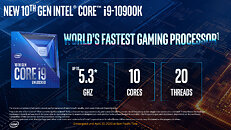
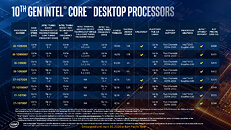
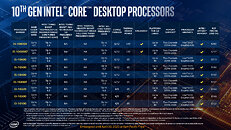
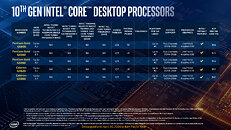



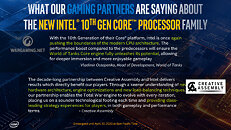



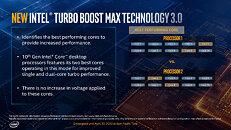
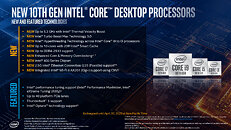
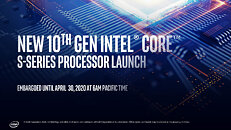
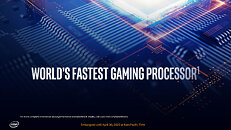

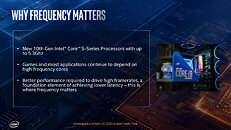








203 Comments on Intel 10th Generation Comet Lake Desktop Processors and 400-Series Chipsets Announced, Here's what's New
The only thing I will say is that the reviews for these CPUs ought to be REALLY interesting, mostly in regards to thermals.
4000 series...
Mainboards...
If you dare...
I hope they come with fire extinguishers... :DYeah. "Slow cores".
As in "brought to you by clowns thinking Intel has IPC advantage"
Damn, I don't see a good reason to switch over Intel right now. LOL
Ryan Shrout was hired for Chief Performance Strategist at Intel. Performance Strategist? Why does Intel need such a thing? To make slow & old processors look nice & shiny on benchmark & performance graphs/slides perhaps? Currently, anything Intel has out to date is pretty much DOA, they will receive the same scrutiny as AMD once did with its Bulldozer release. Even though AMD cleaned that up quite a bit with Piledriver, as Intel also is attempting to clean up its CPUs, they will still be taglined DOA as AMD's Bulldozer back in the day!!!
Chief Performance Strategist is a Red Flag, they should have called it Chief Performance BullShatter!!! :laugh:Nobody should be recommending Intel for gamers when you have better processors out to date called AMD Ryzen 3000 series.
While Zen 2 certainly have multiple advantages, Intel is still better in workloads like gaming, photo editing, video editing, etc.
The right choice depends on the use case of the computer.
They had great products at some point. same as Intel and NVIDIA and for most decent companies.
The 2 tragic things here:
1) much bigger and powerful companies trying to bury the "underdog" when it has the better product, with gray area/sometimes on the verge/plain illegal and anti competitive actions. And when the lawsuit comes they just pay and repeat again, because at the end its more profitable to be punished on your actions then to stop doing them. Do you also think Nvidia's GPP was the greatest thing for consumers? or how the "CPU Discounts" to OEM's lower PC prices ? no they don't, Only one benefits from this are Intel and the Marketing department that can literally do anything and people will still think their new Skylake CPU is the best thing ever shouting "Moar GHz" on forums. when in fact AMD currently has the better IPC. Zen 3 is coming, and if "rumors" are somewhat correct, it should have enough performance to make the Lake series finally irrelevant at everything, no matter what "GHZzzzzz" its running at.
2) Intel not pushing the performance farther, only reason they have higher core counts and lower prices is zen, and that's the real tragedy. how can people be fanboys for a company that did everything to milk their costumers in incremental updates just because they could? the only reason technology came so far is because people keep pushing the boundaries of what is possible.
Some people voted with their wallets and refused to upgrade, Many people with Sandy Bridge/Ivy Bridge didn't have a reason to upgrade to another mainstream platform as paying 350$ for a CPU that is barely twice as fast on the most optimal benchmark, 5 years later was not the Smart move. finally now, that high core count CPU's are mainstream can people upgrade without feeling like they've been ripped off.While they hold the gaming crown for the most part, and usually with small margins. when it comes to photo/video editing depending on the software - zen 2 today, is mostly on par/better vs comparable core count Intel CPU's.
Proc + M/Board is already $700-$800, then another $150-$200 for a cooling solution. - And you WILL need that to cool them.
All that money to boast about higher FPS at 1080p - Jeez....
Oh! I forgot about the 0.0002% of the population who are 'e-athletes', or the other 0.0002% who sit in their mothers basement running PiFast all day to validate their idiocy.
Just buy AMD and spend the money you would've wasted on Intel on a top of the line graphics card.
AMD takes the crown in Video/Photo editing along with pretty much everything else.
And with all due respect, please don't call Factual Information, biased nonsense.Will you see a difference between 150 FPS vs. 180 FPS? I'll answer that easy question 4U. Absolutely NOT. The very very minor FPS increase you get from using Intel's stove heater is not even worse mentioning nowadays. This ain't AMD Bulldozer vs. Intel.
Ryzen 3 3100 is the worst that you could ever get. It has 8 cores in 2 4-core CCXs with all the latency associated between them, 2 cores enabled in the first CCX and 2 cores enabled in the second CCX. This is a recipe for disaster in gaming.
Core i3-10100 is a 65-watt part, what stove heater are you dreaming about ?
And there are numerous others as well. Zen 2 isn't better in every workload.
Battlefield 1: Ryzen 117 FPS Core i7 140 FPS
Crysis 3: Ryzen 57 FPS Core i7 65 FPS
GTA V: Ryzen 115 FPS Core i7 148 FPS
Witcher 3: Ryzen 55 FPS Core i7 62 FPS
But Ryzen 5 1500X has 384 KB L1 cache, while Ryzen 3 1300 has only 256 KB L1 cache.
All performance metrics are already there:
www.cpu-monkey.com/en/cpu-intel_core_i3_10300-1155
www.cpu-monkey.com/en/cpu-intel_core_i7_7700k-664
www.amd.com/en/products/cpu/amd-ryzen-5-1500x
www.amd.com/en/products/cpu/amd-ryzen-3-3100
I will not even Cherry pick like most do here, and will add this one where a 9900K has a HUGE 5% advantage over the 3900X and margin of error with the 3950X..
The 3900X/3950X has the IPC advantage so even with the lower single core boost, they are as fast on less optimized applications.
And lets not forget that in 3D modeling, a similarly priced 3900X can be 40% Faster, 3950X - 86% Faster.
How can a CPU that is slower in most tasks, be a better than the the CPU is faster in most tasks, even when zen 2 is slower than the comparable Intel CPU, its usually by a small margin.
And the platform is an overall better buy, considering that even if AM4 will be dead next year, you still have an upgrade path from a lower tier Ryzen 3000, or older gen ryzen 2/1000 to a 12c/24 CPU or a 16c/36t CPU Ryzen 3000 or the upcoming 4000. Buying Intel's upcoming platform is not even a guarantee that you could update to a 12c let alone 16c in the long run.Did you really use a 190$ CPU to compare to a 350$ one? and with some random VERY POORLY made video?
Unlike your beloved "Insert some random lake and call it a new product because the road map is a failed mess", zen 2 had major changes in the way its built.
And unlike i7 7700K owners who stuck on 4c8t, the 1500X owners can spend under 200$ to get a new R5 3600. if you have an X370 motherboard with decent VRM you can even install a 3950X on it after a BIOS update. no "x-lake" owner can do that on their mainstream platform.
AMD made their moves by Pricing lower than the competitors (cpu at the same tier) and the single core performance loss is not that much that people are willing to switch. It’s just marketing done somewhat right for both sides.
At the point of writing this comment, 3900x is hovering at $400 retail price (2) with cooler included while Intel 10900k pricing is at $488 (per slides released in page 1 of this thread).
Davinci resolve users may find Intel new i9 10900K CPU a little faster (3) but at 20% more expensive than AMD, is it worth the cost? Only the end users can tell. Purchasing decision varies base on disposable income.
Common office workers who deal mostly with Excel spreadsheets will likely enjoy whatever the company gives them and that’s most likely be an Intel machine because of OEM support. But situation may change since more manufacturers are adding AMD to their line up because it’s a little bit easier on the pricing (see recent new AMD laptop with AMD 4000 series cpu).
With Intel releasing new processors, I expect AMD to further cut the price to become more competitive. And I hope new AMD cpu will have better IPC to compete.
At this point, you can’t be wrong buying either side because both bring great performance at somewhat acceptable price range.
I am very happy to see competition because that’s what drive innovations.
(1) www.statista.com/statistics/748044/number-video-gamers-world/
(2) www.microcenter.com/product/608316/amd-ryzen-9-3900x-matisse-38ghz-12-core-am4-boxed-processor-with-wraith-prism-cooler
(3) www.pugetsystems.com/labs/articles/DaVinci-Resolve-Studio-CPU-Performance-Intel-Core-X-10000-vs-AMD-Threadripper-3rd-Gen-1630/